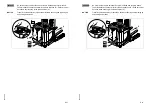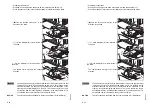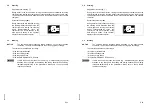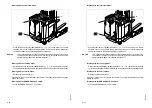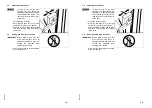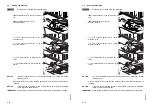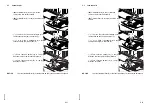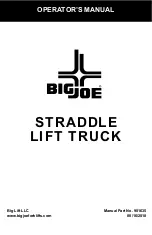
E 45
0
608
.USA
4.4
Operating environment
Danger zone:
The "danger zone" refers to the area in which people are put at risk by
the travel or lifting movements of the industrial truck or of its load-handling equipment
(such as the forks or attachments, for example) or by the loads to be transported. It
also includes the possible impact zone of falling loads or falling or lowering
attachments.
Q
wW
Unauthorized people must be asked to leave the danger zone. The driver
must indicate the possible development of a hazard situation for people by
sounding a warning signal. The industrial truck must be stopped immediately
if people do not leave the hazard zone, even though requested to do so.
The owner is responsible for classifying the atmosphere or hazard zones in
accordance with ANSI / NFPA 505.
The industrial trucks used in hazard zones and the batteries used there must carry
appropriate approval and satisfy the requirements of ANSI / NFPA 505.
Industrial trucks and their areas of use must be labeled in accordance with ANSI /
NFPA 505.
Braking distance (slopes):
When driving on a slope, the braking distance is longer
than on a horizontal surface. To compensate for this circumstance, various
precautions must be taken. These precautions include the following: Reduce speed,
limit loads, ensure sufficient space at the bottom of the slope, etc.
The braking distance of a vehicle depends on many factors, including traffic in the
form of other vehicles and pedestrians, the available space, the nature of the ground,
and the stability of the load(s).
The decisive factor is that any use of the emergency brake system fully stops the
vehicle before it strikes an obstacle.
Particular care is required in situations where the environmental conditions have
changed. Changes to the weather, the ground surface or the application can have a
negative effect on the braking distance, so the maximum speed, the braking settings
and / or the operation of the vehicle must be adjusted accordingly.
Gangways and obstacles:
Permanent gangways, travel ways or passages, floors
and ramps must be marked appropriately in accordance with ANSI Z535.2.
Areas to which access by industrial trucks is not permitted must also be indicated
and / or marked.
In areas to which access is permitted, the area needed for the industrial truck and its
load and / or attachments and the space required for turning and maneuvering must
be clearly marked.
Automatic doors and blind corners must be fitted with appropriate acoustic and / or
visual warning systems to indicate an approaching industrial truck or the operation of
the door. Passive devices – such as mirrors – are also recommended.
A distance of at least 1.5 ft (450 mm) must be maintained between obstacles and
freely movable industrial trucks (including load). All other areas with limited space
must be closed to industrial trucks and be clearly identified by signs, markers, light
signals, or other means.
E 45
0
608
.USA
4.4
Operating environment
Danger zone:
The "danger zone" refers to the area in which people are put at risk by
the travel or lifting movements of the industrial truck or of its load-handling equipment
(such as the forks or attachments, for example) or by the loads to be transported. It
also includes the possible impact zone of falling loads or falling or lowering
attachments.
Q
wW
Unauthorized people must be asked to leave the danger zone. The driver
must indicate the possible development of a hazard situation for people by
sounding a warning signal. The industrial truck must be stopped immediately
if people do not leave the hazard zone, even though requested to do so.
The owner is responsible for classifying the atmosphere or hazard zones in
accordance with ANSI / NFPA 505.
The industrial trucks used in hazard zones and the batteries used there must carry
appropriate approval and satisfy the requirements of ANSI / NFPA 505.
Industrial trucks and their areas of use must be labeled in accordance with ANSI /
NFPA 505.
Braking distance (slopes):
When driving on a slope, the braking distance is longer
than on a horizontal surface. To compensate for this circumstance, various
precautions must be taken. These precautions include the following: Reduce speed,
limit loads, ensure sufficient space at the bottom of the slope, etc.
The braking distance of a vehicle depends on many factors, including traffic in the
form of other vehicles and pedestrians, the available space, the nature of the ground,
and the stability of the load(s).
The decisive factor is that any use of the emergency brake system fully stops the
vehicle before it strikes an obstacle.
Particular care is required in situations where the environmental conditions have
changed. Changes to the weather, the ground surface or the application can have a
negative effect on the braking distance, so the maximum speed, the braking settings
and / or the operation of the vehicle must be adjusted accordingly.
Gangways and obstacles:
Permanent gangways, travel ways or passages, floors
and ramps must be marked appropriately in accordance with ANSI Z535.2.
Areas to which access by industrial trucks is not permitted must also be indicated
and / or marked.
In areas to which access is permitted, the area needed for the industrial truck and its
load and / or attachments and the space required for turning and maneuvering must
be clearly marked.
Automatic doors and blind corners must be fitted with appropriate acoustic and / or
visual warning systems to indicate an approaching industrial truck or the operation of
the door. Passive devices – such as mirrors – are also recommended.
A distance of at least 1.5 ft (450 mm) must be maintained between obstacles and
freely movable industrial trucks (including load). All other areas with limited space
must be closed to industrial trucks and be clearly identified by signs, markers, light
signals, or other means.
Содержание ETR 314
Страница 1: ...Operating instructions 50 452 907 ETR 314 320 u 06 06 11 09 07 08 E Manual de instrucciones...
Страница 7: ...0608 USA I 4 0608 USA I 4...
Страница 9: ...0606 USA A 2 0606 USA A 2...
Страница 24: ...D 9 0107 USA D 9 0107 USA...
Страница 26: ...D 11 0107 USA D 11 0107 USA...
Страница 103: ...0107 USA F 10 0107 USA F 10...
Страница 123: ...0708 USA G 20 0708 USA G 20...
Страница 135: ...0608 E I 4 0608 E I 4...
Страница 137: ...0606 E A 2 0606 E A 2...
Страница 152: ...D 9 0107 E D 9 0107 E...
Страница 154: ...D 11 0107 E D 11 0107 E...
Страница 162: ...E 3 0608 E 1 2 18 17 4 5 3 6 7 8 9 10 11 12 13 14 15 16 E 3 0608 E 1 2 18 17 4 5 3 6 7 8 9 10 11 12 13 14 15 16...
Страница 164: ...E 5 0608 E 1 2 18 17 4 5 3 6 7 8 9 10 11 12 13 14 15 16 E 5 0608 E 1 2 18 17 4 5 3 6 7 8 9 10 11 12 13 14 15 16...
Страница 225: ...0608 E E 66 0608 E E 66...
Страница 235: ...0107 E F 10 0107 E F 10...
Страница 255: ...0708 E G 20 0708 E G 20...

